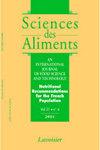Milk fats : A différent perspective
引用次数: 9
Abstract
The recent history of public recommendations for dietary intakes of macronutrients have targeted total fat, cholesterol and saturated fat intake as the principle means to improve human health. Such recommendations have been translated into a long term agricultural objective of eliminating these components from human foods. Agricultural change requires changes at many points over many years to eliminate these components. Once accomplished, such changes would be equally difficult to reverse. Furthermore, such recommendations fall disproportionately on a few commodities most notably dairy fats. Dramatic alterations in dairy consumption carry much more impact on dietary intakes than simply total fat, saturated fat and cholesterol. While it is becoming possible to alter the basic production of milk and dairy products and to envision a dramatically different milk fat composition, such steps will be difficult and expensive. Hence, it is appropriate to ask whether the data in support of this conclusion are complete and if indeed a finite intake of milk fats are beneficial to overall health. Mammalian milks, including human milk contain 50% of their total fatty acids as saturated fatty acids. Adding a single double bond is a relatively straightforward process already active within the mammary gland. Darwinian selective pressure therefore chose to maintain a significant content of saturated fatty acids in milk. Is it possible evolution found benefits to saturated fatty acids that current recommendations do not consider? Furthermore, milk does not contain simply saturated triglycerides as a bulk fat, but rather a conspicuous range of different fatty acids varying in chain length and unsaturation. Milk is present as highly complex globules with structural properties distinct from other biological sources of fats. In particular, there are complex phospholipids making up a highly glycosylated and protein embedded plasma membrane around each milk fat globule. Milkfat is thus a source of bioactive lipids provided as highly absorbable ensembles also serving as an important delivery medium for nutrients, including the fat-soluble vitamins. While very few studies have examined the nutritional consequences of these structures and compositions, their emergence through evolution implies that they provide distinct benefits to individuals consuming them.牛奶脂肪:一个不同的视角
近期公众对饮食中常量营养素摄入量的建议将总脂肪、胆固醇和饱和脂肪摄入量作为改善人类健康的主要手段。这些建议已经转化为从人类食品中消除这些成分的长期农业目标。农业变革需要在许多年的许多时间点上进行变革,以消除这些因素。这些变化一旦完成,将同样难以逆转。此外,这些建议不成比例地落在几种商品上,尤其是乳制品脂肪。乳制品消费的巨大变化对饮食摄入的影响远不止总脂肪、饱和脂肪和胆固醇。虽然改变牛奶和奶制品的基本生产方式并设想一种截然不同的乳脂成分正在成为可能,但这些步骤将是困难和昂贵的。因此,我们有必要问一下,支持这一结论的数据是否完整,有限摄入牛奶脂肪是否确实对整体健康有益。哺乳动物的牛奶,包括人乳,其总脂肪酸中有50%是饱和脂肪酸。添加一个单双键是一个相对简单的过程,已经在乳腺中活跃。因此,达尔文的选择压力选择了保持牛奶中饱和脂肪酸的显著含量。有没有可能进化发现了饱和脂肪酸的好处,而目前的建议没有考虑到这一点?此外,牛奶并不仅仅含有饱和甘油三酯作为散装脂肪,而是含有一系列链长和不饱和程度不同的不同脂肪酸。牛奶是一种高度复杂的小球体,具有与其他生物脂肪来源不同的结构特性。特别是,在每个乳脂球周围,有复杂的磷脂构成了一个高度糖基化和蛋白质嵌入的质膜。因此,乳脂是生物活性脂质的来源,是高度可吸收的整体,也是营养物质(包括脂溶性维生素)的重要输送介质。虽然很少有研究调查这些结构和成分对营养的影响,但它们在进化过程中的出现意味着它们对食用它们的个体有明显的好处。
本文章由计算机程序翻译,如有差异,请以英文原文为准。
求助全文
约1分钟内获得全文
求助全文

 求助内容:
求助内容: 应助结果提醒方式:
应助结果提醒方式:


